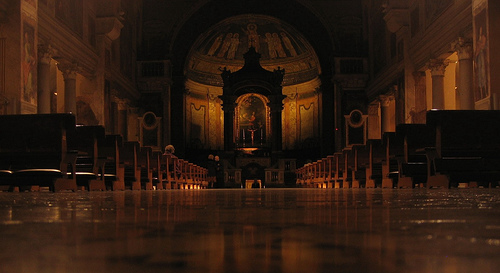The Dahesh Museum displays cursed art. Cursed, that is, by the Art Establishment. It consists of 19th century paintings and sculptures that are not "revolutionary," that for the most part have no political and social message, and that are figurative. The paintings' subjects are historical, mythological, and picturesque. The same could be said of many Renaissance works certified by the experts as masterpieces, but according to them, that's not what the 19th century was about. The only art that matters from the period, they say, is impressionist and post-impressionist. Everything else is naively pictorial and quaint: "academic" is the damning expression. This is what the impressionist darlings rebelled against and saved us from.
Lawrence Alma Tadema,
Joseph, Overseer of Pharaoh's Granaries
The true "academics" are today's institutional academics, mostly college teachers who write textbooks. They are herd animals. In their quest for the Holy Grail of tenure, they take in each other's washing and parrot the same line: modernism is the peak of perfection; the imps and post-imps were heroic pioneers in its development. The other styles in which many artists continued to work, contemporaneously with the imps, can only be derided. By the time these experts have been given their cardinal's capes and tenure, they have long since lost any ability they might once have had for independent thought or unprejudiced observation.Joseph, Overseer of Pharaoh's Granaries
You will gather that I am rather fond of many of these so-called "academic" artists of the 19th century, which is why I visited the Dahesh Museum on a visit to New York last week.
Henri Lehmann, Adoration of the Magi
Certainly, not everything in the Dahesh is great. The same could be said about the Metropolitan Museum or the Museum of Modern Art. But the Dahesh collection includes a number of vivid and impressive items, which display both first-rate craftsmanship and splendid imagination. Unfortunately for the reputation of the artists, it's not the "right" kind of imagination. We have had it tatooed on our brains that scenes of the ancient world, or a fantasy Middle East, are not to be taken seriously (if they're by 19th century artists, who should have known better).
Henri Lehmann's painting shown above uses a remarkable glowing impasto to suggest the jewels and silk of one of the kings. Jean Lecomte du Nouÿ's Night Scene Near Gezeh, Egypt is a richly evocative canvas showing an adobe-like building in deep shadow under a cobalt sky, the only accent an L-shaped , fiery sliver from somewhere within the building.
Two unusual pictures by Alma Tadema (the museum spells his name without a hyphen, so I will do the same here) are hung. One is the narrow, vertical The Staircase, its central figure -- a woman in Roman costume -- seen from the back, ascending. We are left to ponder what the context could be. Another contrasts with Alma Tadema's usual classical setting: Joseph displays the artist's quasi-time-travel realism, taking us this time to ancient Egypt. Edwin Long's Love's Labour Lost is another essay in exotic and erotic historicism. Realistic, no, but captivating.

Edwin Long, Love's Labour Lost
Certainly, not everything in the Dahesh is great. The same could be said about the Metropolitan Museum or the Museum of Modern Art. But the Dahesh collection includes a number of vivid and impressive items, which display both first-rate craftsmanship and splendid imagination. Unfortunately for the reputation of the artists, it's not the "right" kind of imagination. We have had it tatooed on our brains that scenes of the ancient world, or a fantasy Middle East, are not to be taken seriously (if they're by 19th century artists, who should have known better).
Henri Lehmann's painting shown above uses a remarkable glowing impasto to suggest the jewels and silk of one of the kings. Jean Lecomte du Nouÿ's Night Scene Near Gezeh, Egypt is a richly evocative canvas showing an adobe-like building in deep shadow under a cobalt sky, the only accent an L-shaped , fiery sliver from somewhere within the building.
Two unusual pictures by Alma Tadema (the museum spells his name without a hyphen, so I will do the same here) are hung. One is the narrow, vertical The Staircase, its central figure -- a woman in Roman costume -- seen from the back, ascending. We are left to ponder what the context could be. Another contrasts with Alma Tadema's usual classical setting: Joseph displays the artist's quasi-time-travel realism, taking us this time to ancient Egypt. Edwin Long's Love's Labour Lost is another essay in exotic and erotic historicism. Realistic, no, but captivating.

Edwin Long, Love's Labour Lost
As I implied in describing Lehmann's Adoration, these "academic" paintings are by no means necessarily just good draftsmanship with color applied; some show an individual, or even a proto-impressionist, technique. In the special exhibition "Napoleon on the Nile" (closing December 31, the day of this posting), which includes works by the artists that Napoleon took with him to document the wonders of the Egypt he invaded with his army in 1798, Joseph Farquharson's Ruins of the Temple at Luxor is painted in soft focus, the air permeated with dust haze, a study in tan and brown that I think Whistler would have admired. An Italian Woman by Léon Bonnat (in the Dahesh's permanent collection) puts you in mind of Corot, even to the splash of red in the subject's necklace.

Rafaelle Monti, Night

Rafaelle Monti, Night
For an extraordinary venture into the realms of mystery, the prize of the museum to my mind is Monti's sculpture Night. (What, you've never heard of him? Okay, neither had I. One of the benefits of a museum like the Dahesh is to open doors that remain firmly shut in art history texts.) A shrouded female strides up and forward, like a spirit arising from the earth, holding a shroud blown by winds from regions unknown. Night could easily be the centerpiece of a show of symbolist art, itself a genre that gets only grudging acknowledgement from the Art Establishment.
According to the museum's web site, "the Dahesh Museum of Art's permanent collection originated with Dr. Dahesh (1909–1984), the pen name of Salim Moussa Achi, an influential Lebanese writer, philosopher, and connoisseur, in whose honor the Museum is named. Envisioning a premier art museum, he collected paintings, sculptures, drawings, prints, photographs, and books by academically trained artists of the 19th and 20th centuries. Friends brought Dr. Dahesh's collection from Beirut to America in 1976 and founded the museum in 1987. For the next few years, the collection was researched and conserved, a location was secured, and exhibitions were prepared, all before opening to the public in 1995."
Dr. Dahesh seems to have been a man who followed his own star, oblivious to the fashionable certainties of received opinion. Good on him. Assuming that Western civilization survives its present Time of Troubles, its artistic taste may eventually catch up with him.
According to the museum's web site, "the Dahesh Museum of Art's permanent collection originated with Dr. Dahesh (1909–1984), the pen name of Salim Moussa Achi, an influential Lebanese writer, philosopher, and connoisseur, in whose honor the Museum is named. Envisioning a premier art museum, he collected paintings, sculptures, drawings, prints, photographs, and books by academically trained artists of the 19th and 20th centuries. Friends brought Dr. Dahesh's collection from Beirut to America in 1976 and founded the museum in 1987. For the next few years, the collection was researched and conserved, a location was secured, and exhibitions were prepared, all before opening to the public in 1995."
Dr. Dahesh seems to have been a man who followed his own star, oblivious to the fashionable certainties of received opinion. Good on him. Assuming that Western civilization survives its present Time of Troubles, its artistic taste may eventually catch up with him.










